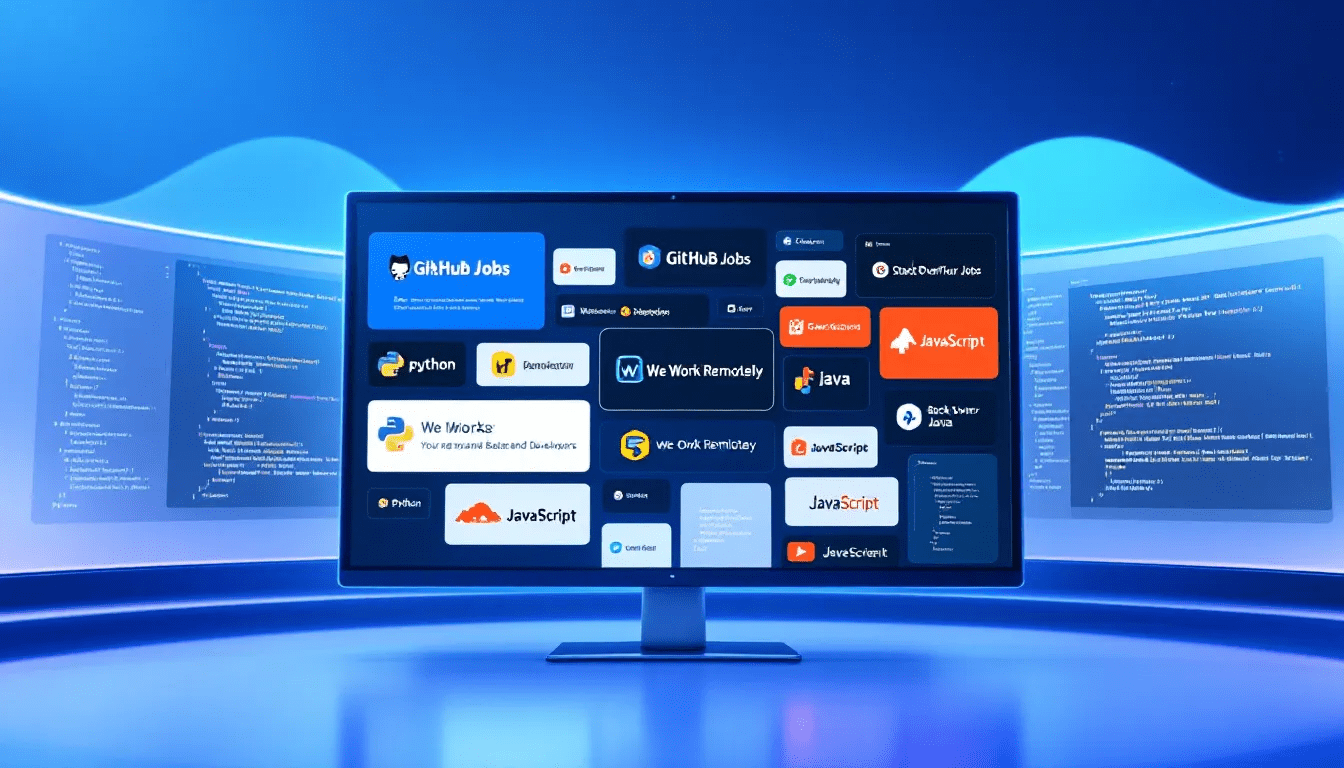Struggling to hire backend developers? This article lists the top 10 platforms to hire skilled backend developers in 2025, helping you find the right talent for your projects quickly and effectively.
Key Takeaways
- Backend developers are crucial for optimizing server performance, ensuring scalable applications, and managing databases, making their expertise essential for any digital project.
- When hiring backend developers, prioritize candidates with proficiency in multiple programming languages, familiarity with cloud services, and strong problem-solving abilities to ensure they meet project demands.
- Utilize structured hiring processes that include clearly defining project requirements, evaluating candidates through practical assessments, and offering flexible engagement models to find suitable backend developer talent.
What Makes a Backend Developer Essential?

Backend developers are the unsung heroes of the digital world. They optimize server performance and ensure the scalability of applications. In a world where user demands are constantly increasing, having a backend developer who can create efficient backend solutions is crucial. These developers are responsible for the server-side logic that powers your application, making sure that data flows smoothly between the server and the client, including aspects of back end development.
Backend developers must be proficient in server-side programming languages like Python, Java, and PHP to achieve this. These languages are the backbone of backend development, allowing developers to write the code that processes user requests and interacts with databases. Speaking of databases, a backend developer must also be skilled in managing various databases like MySQL, PostgreSQL, and MongoDB. Databases like MySQL, PostgreSQL, and MongoDB are critical for storing and retrieving data.
Moreover, backend developers need to be adept at using web hosting platforms such as AWS and Google Cloud to deploy applications. They create and manage APIs that enable different software components to interact seamlessly. The communication between databases and applications, a responsibility of backend developers, is crucial for maintaining data integrity and ensuring the smooth functioning of applications.
Without skilled backend developers, the backbone of your application would crumble, leading to downtime and user dissatisfaction.
Key Skills to Look for When Hiring Backend Developers
When hiring backend developers, it’s essential to look for a versatile skill set that can adapt to various technologies and solve complex issues. Proficiency in programming languages such as Python, JavaScript, Ruby, Go, and PHP is a must. These languages form the foundation of backend development, and a skilled developer should be comfortable working with multiple languages based on project requirements.
Familiarity with cloud services like AWS, Azure, and Google Cloud is also essential. Modern backend development often leverages cloud platforms to manage infrastructure and optimize application performance. A good backend developer should also have strong capabilities in database interaction, including designing and optimizing schemas and ensuring data integrity. This capability is vital for addressing scalability and performance challenges.
Moreover, backend developers should be skilled in integrative processes, such as providing seamless integration with third-party APIs and legacy systems. They must be able to evaluate trade-offs between managed services and self-hosted infrastructure, a critical skill for making informed decisions during development.
Implementing coding solutions through tests, projects, and technical interviews verifies the candidate’s skills. These skills collectively ensure that the backend developer can contribute effectively to your software development projects.
Proven Steps to Hire Backend Developers
Hiring backend developers involves a structured process to ensure you find the right fit for your project. The first step is understanding your project and team requirements, including areas of expertise, timeframe, budget, and project goals. This clarity helps in identifying the ideal backend developer to hire backend developer who can meet your specific needs.
Once you have a clear understanding of your requirements, the next step is to evaluate candidates. This involves sharing your project details and assessing candidates through various methods to find the right fit. Finally, the hiring process is completed by negotiating contracts and onboarding the new developer, ensuring a smooth transition and integration into your team.
The subsections below will delve deeper into each of these steps, providing detailed guidance on defining your project requirements, evaluating candidates’ abilities, and finalizing the hiring process.
Define Your Project Requirements
The foundation of hiring a backend developer starts with a clear definition of your project requirements. This typically involves sharing detailed project information, including the technologies and programming languages needed. Common backend languages like Ruby, Python, and PHP should be specified based on your project’s needs. Clearly defining these requirements is crucial for successfully hiring backend developers.
Aligning your project requirements with the candidate’s technical skills is vital for success. This alignment helps in identifying candidates who possess the right expertise and are capable of contributing effectively to the project’s goals. Thoroughly defining your project requirements sets the stage for a successful hiring process.
Evaluate Candidate’s Ability
Evaluating a candidate’s ability is a critical step in the hiring process. This can be done through various methods such as project simulations, coding tests, and pair programming exercises. These methods provide insights into the candidate’s technical skills and their ability to solve real-world problems. Assessing candidates’ abilities is crucial in selecting qualified backend developers who can meet the demands of your project.
In addition to technical skills, it’s important to evaluate the candidate’s problem-solving abilities and communication skills. These soft skills are essential for effective collaboration within your development team. Comprehensive evaluation methods provide insight into the candidate’s overall fit for your project.
Finalize the Hiring Process
Finalizing the hiring process involves several critical steps. The first is contract negotiations, where clear terms regarding compensation, work expectations, and project deliverables are established. This ensures that both the developer and the employer are aligned in their intentions and expectations.
The next step is onboarding the new backend developer into your team. This involves training on project tools, company culture, and specific coding practices. Open communication and providing resources to help new developers adjust to their roles effectively is crucial for fostering collaboration from the outset.
Following these steps ensures a smooth transition and integration of the new developer into your team.
Top Sites to Find and Hire Backend Developers

Finding the right platform to hire backend developers can be a game-changer. Upwork, for instance, offers a diverse pool of over 12 million freelancers, including a freelance back end developer, with protective measures for payments. CyberCoders helps match employers with pre-screened backend developer candidates and facilitates interviews within five days. If you’re looking for a more managed approach, Gigster assigns product managers to coordinate between clients and backend developer teams, simplifying the process of hiring back end developers.
Ruby Jobs caters specifically to employers seeking Ruby or Ruby on Rails backend developers. Drupal Jobs connects employers with developers proficient in the Drupal content management system, while WP Hired is dedicated to WordPress web development jobs, making it an ideal platform to find PHP backend experts.
RemoteOK focuses on connecting employers with remote backend developers and is trusted by major companies for critical tech projects. X-Team offers not only backend developer talent but also mentorship and educational resources as part of their service.
Lastly, Authentic Jobs is a job board that connects employers with UI, UX, frontend, and backend developers, including high-profile companies. Each of these platforms offers unique benefits, catering to different hiring needs and project specifications.
Benefits of Hiring Dedicated Backend Developers

Hiring dedicated backend developers brings numerous advantages. These developers manage backend operations exclusively, resulting in stable and efficient systems. This stability is especially important for projects that require advanced security measures, such as those in sensitive industries. Focusing solely on backend tasks, dedicated developers ensure the system remains reliable and secure.
Dedicated backend developers are also crucial for managing complex server infrastructures in large-scale projects. They provide tailored solutions that cater to the unique needs of various industries. Maintaining a collaborative and transparent development process is a hallmark of hiring dedicated backend developers, which fosters trust and ensures the project’s success.
How to Write an Effective Job Description for Backend Developers

An effective job description is key to attracting the right backend developers. Start by outlining the key technical skills required, such as database management, application development, and familiarity with cloud providers. Candidates should have experience integrating multiple data sources. This experience is considered ideal for the role. Clearly define specific goals and objectives that the backend developer will need to achieve.
Include project specifics and challenges to give candidates insights into what to expect. Use bullet points to summarize qualifications, objectives, and responsibilities, enhancing readability.
The job description should reflect the company’s culture and provide insight into the backend developer’s role. Ensure the description is clear, concise, and engaging to attract suitable candidates.
Interview Questions to Ask When Hiring Backend Developers
Asking the right interview questions is crucial when hiring backend developers. Inquire about the candidate’s familiarity with specific programming languages to gauge their technical expertise. Questions about their experience with API development can assess their practical skills. Understanding a candidate’s knowledge of database management is essential for evaluating their data handling capabilities.
Additionally, ask about their experience with cloud services to reveal their capability in modern backend development practices. Questions regarding debugging approaches can indicate their problem-solving abilities. Finally, discussing their experience with performance optimization can help determine their ability to enhance system efficiency.
These questions collectively help select the most qualified candidates for your development team.
Flexible Engagement Models for Hiring Backend Developers
Flexible engagement models offer businesses the ability to hire backend developers based on project demands. These models can include full-time, part-time, and project-based arrangements, providing flexibility in terms of budget and project specifications.
Selecting an engagement model that aligns with your specific needs helps efficiently manage resources and ensure project success.
Ensuring Optimal Performance with Backend Development Services
Several strategies are involved in ensuring optimal performance with backend development services. Caching mechanisms significantly reduce backend load by storing frequently accessed data in memory. Optimizing database access through indexing and caching can reduce query latency and enhance performance. Asynchronous and event-driven communication improves throughput by allowing parallel processing of tasks.
Load balancing distributes traffic among servers to prevent any single server from becoming overloaded. Horizontal scaling involves adding more servers to handle increased traffic efficiently. Ongoing maintenance and support make dedicated backend teams ideal for long-term projects. Regular performance monitoring helps identify and resolve bottlenecks, ensuring optimal scalable backend solutions functionality.
Future Trends in Backend Development

The future of backend development is being shaped by several emerging trends that promise to transform the industry. One of the most significant trends is microservices architecture, which breaks applications into smaller, independent services that communicate via APIs. This architecture provides several advantages. These include simpler deployment, improved fault isolation, and the capacity to scale individual services independently.
Familiarity with microservices architecture shows a backend developer’s capability to design complex systems. It also highlights their skill in managing scalable environments. This approach enhances scalability and flexibility, making it easier to update and maintain applications. As more companies adopt microservices, backend developers with this expertise will be in high demand.
Other emerging trends include the integration of AI and machine learning into backend systems, which can automate routine tasks and improve data analysis for better decision-making. Additionally, advancements in serverless computing and the use of containerization tools like Docker and Kubernetes are revolutionizing how backend services are deployed and managed.
Staying up to date with these latest technologies is crucial for backend developers to remain competitive in the field.
Summary
In summary, hiring skilled backend developers is essential for creating robust, scalable systems that can meet the demands of modern applications. Understanding the key skills to look for, following a structured hiring process, and using the right platforms to find talent are all critical steps in ensuring you bring the best backend developers onto your team. Dedicated backend developers provide stability, security, and tailored solutions that are invaluable for complex projects.
As we look to the future, staying informed about the latest trends and technologies in backend development will help you maintain a competitive edge. By following the guidance provided in this blog post, you can make informed decisions and build a strong backend development team that drives your projects to success.
Frequently Asked Questions
What are the key skills to look for when hiring backend developers?
When hiring backend developers, it is essential to prioritize proficiency in programming languages like Python and JavaScript, experience with cloud services such as AWS, strong database management skills, and effective problem-solving abilities. These key competencies ensure that the developer can effectively contribute to your team’s success.
What are the steps to hire backend developers?
To successfully hire backend developers, first define your project requirements, then evaluate candidates through coding tests and project simulations, and finally, conclude the process with contract negotiations and onboarding.
What are the benefits of hiring dedicated backend developers?
Hiring dedicated backend developers ensures the creation of stable and efficient systems while offering advanced security measures and tailored solutions for complex projects. Their expertise fosters a collaborative development process, ultimately enhancing the overall quality of your application.
What are some top sites to find and hire backend developers?
For hiring backend developers, consider utilizing platforms such as Upwork, GitHub Jobs, and RemoteOK, as they offer a wide range of qualified candidates. These sites provide effective solutions for sourcing skilled professionals for your development needs.
What are the future trends in backend development?
The future of backend development will be heavily influenced by trends such as microservices architecture, integration of AI and machine learning, serverless computing, and the adoption of containerization tools like Docker and Kubernetes. These innovations are set to enhance scalability, efficiency, and responsiveness in application development.
